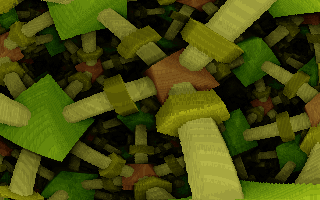Puls - revolution in 256 byte intro
The Chaos Constructions 2009 in St. Petersburg at the end of August , unfortunately, did not please us with revolutionary releases. However, the foreign brothers demosceners are not asleep!

Just last week at Riverwash 2009, a simple Czech guy Jan Kadlec (aka Řrřola) bombed a PC 256 byte intro which established a new world order. His name is Puls.
So this is a piece of machine code of 256 bytes for an Intel x86 compatible machine. It works under DOS, it is completely indifferent to the 3D capabilities of your video card and the amount of installed RAM, but it will not refuse a fast CPU. The code generates a dynamic visual scene using the basic capabilities of Intel architecture and standard video mode.
Actually, I hope everyone has an understanding of what 256 bytes are on a scale of at least the text of an SMS message, and how much this engine can fit in is still incomprehensible to many. At the same time, there is an assembler source code that makes you believe.
Usually in this place the layman asks the question: “Great! And how can we use this? ”
I answer with an example for the 9th grade:
Voyager 1 is a 722-pound automatic probe exploring the solar system and its surroundings since September 1977. In the fall of 2008, Voyager 1 was approximately 107.58 a. e. (16,093 billion km) from the Sun, going beyond the limits of the solar system. On board the ship are three radioisotope thermoelectric generators that provide power to the probe. There is radio communication with him and the ship can transmit and receive telemetry data.
One problem - the signal goes to the ground for 14 hours. At the same time, the Internet does not tell us how fast the exchange is going on, but it can be assumed that it does not exceed 300 baud (the industrial standard of those times).
In short, very, very slow. Now imagine what is needed to this probe SUDDENLY, in one package, to pass on the information about changing the trajectory of movement, switching on high beams and foglights, as well as launching a visual greeting program for residents of other galaxies. Moreover, the video sequence of this greeting must be transferred to the probe again - the old recording of 1977 is no longer relevant in the light of recent political changes.
Here in such a situation, the art of programming a compact, but functional code for the processor standing on Voyager-1 can not do!
Such an example.
If there are problems downloading via direct http links, use the mirror at ftp.scene.org/incoming/parties/riverwash2009/in256

Just last week at Riverwash 2009, a simple Czech guy Jan Kadlec (aka Řrřola) bombed a PC 256 byte intro which established a new world order. His name is Puls.
So this is a piece of machine code of 256 bytes for an Intel x86 compatible machine. It works under DOS, it is completely indifferent to the 3D capabilities of your video card and the amount of installed RAM, but it will not refuse a fast CPU. The code generates a dynamic visual scene using the basic capabilities of Intel architecture and standard video mode.
- comments from demosceners look at Pouet
- version for DOS (just 256 bytes) + sources on asm : rrrola.wz.cz/files/puls.zip
- adapted version to run on Windows + .scr : rrrola.wz.cz/files/puls_win.zip
- 5 sec. video on You Tube (thanks zencd ) and longer version (thanks nord_ak )
Actually, I hope everyone has an understanding of what 256 bytes are on a scale of at least the text of an SMS message, and how much this engine can fit in is still incomprehensible to many. At the same time, there is an assembler source code that makes you believe.
Usually in this place the layman asks the question: “Great! And how can we use this? ”
I answer with an example for the 9th grade:
Voyager 1 is a 722-pound automatic probe exploring the solar system and its surroundings since September 1977. In the fall of 2008, Voyager 1 was approximately 107.58 a. e. (16,093 billion km) from the Sun, going beyond the limits of the solar system. On board the ship are three radioisotope thermoelectric generators that provide power to the probe. There is radio communication with him and the ship can transmit and receive telemetry data.
One problem - the signal goes to the ground for 14 hours. At the same time, the Internet does not tell us how fast the exchange is going on, but it can be assumed that it does not exceed 300 baud (the industrial standard of those times).
In short, very, very slow. Now imagine what is needed to this probe SUDDENLY, in one package, to pass on the information about changing the trajectory of movement, switching on high beams and foglights, as well as launching a visual greeting program for residents of other galaxies. Moreover, the video sequence of this greeting must be transferred to the probe again - the old recording of 1977 is no longer relevant in the light of recent political changes.
Here in such a situation, the art of programming a compact, but functional code for the processor standing on Voyager-1 can not do!
Such an example.
If there are problems downloading via direct http links, use the mirror at ftp.scene.org/incoming/parties/riverwash2009/in256
